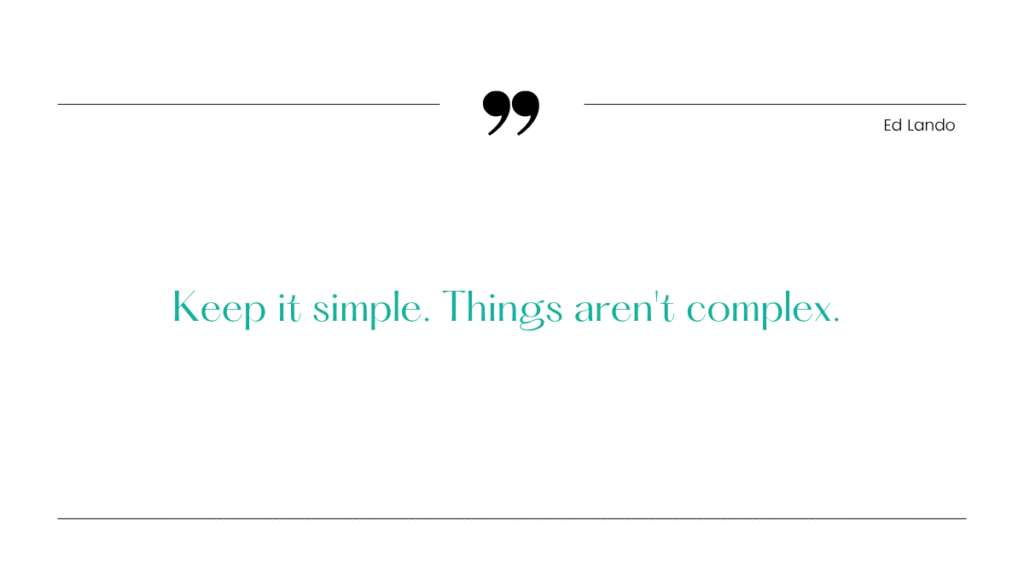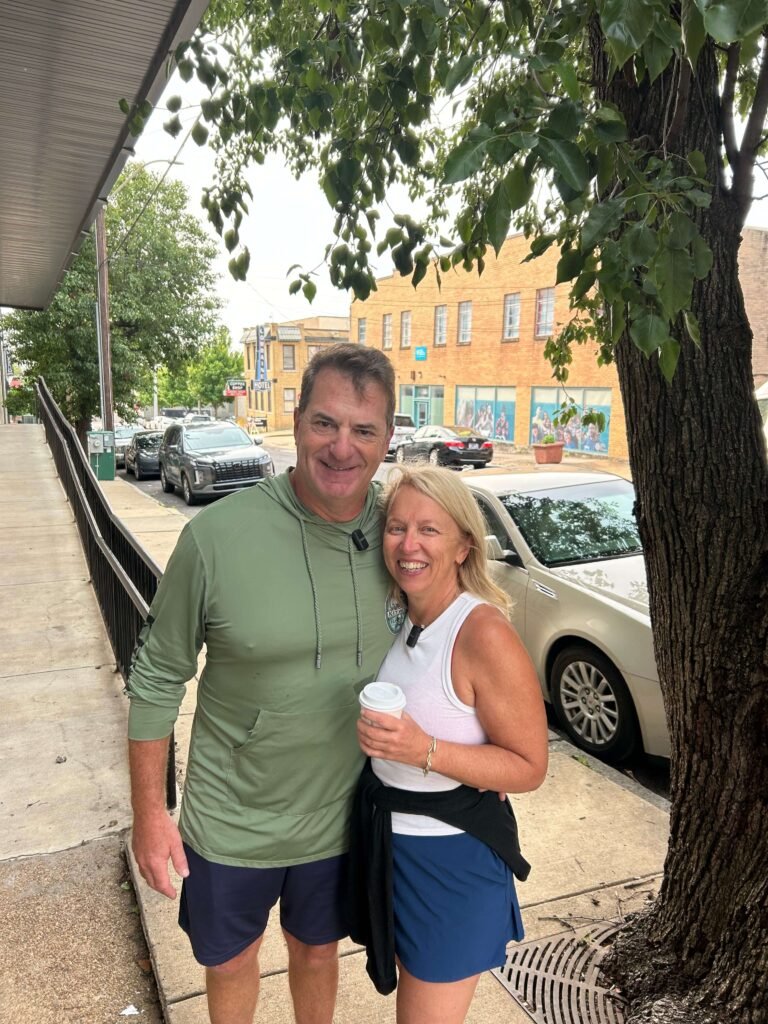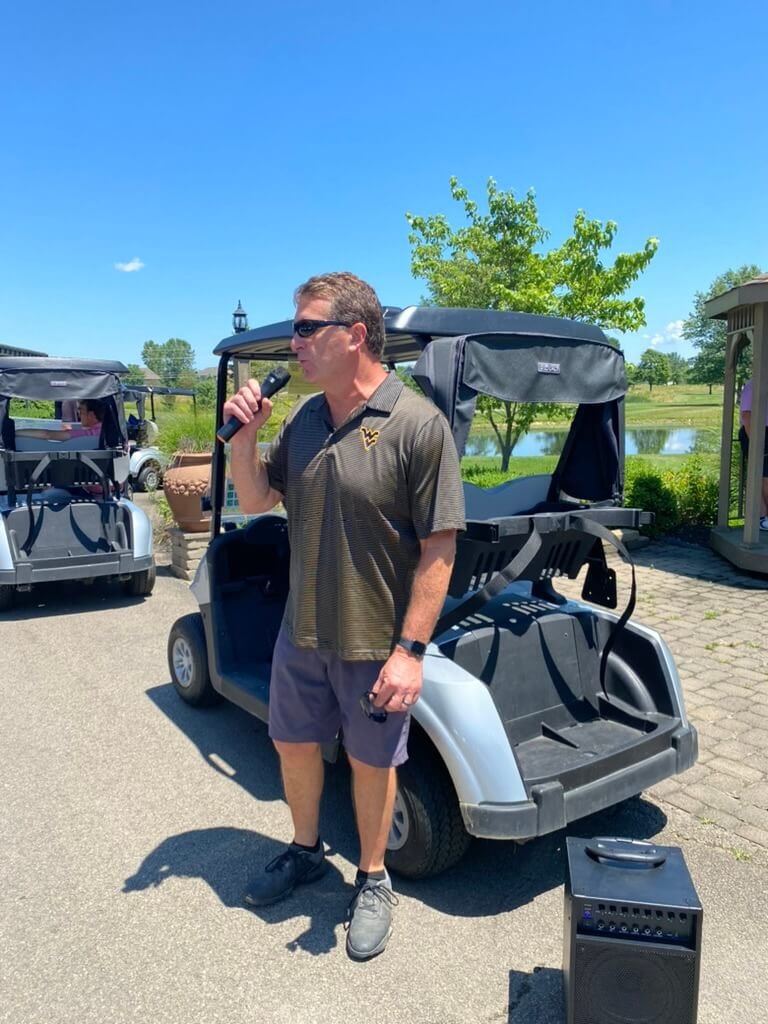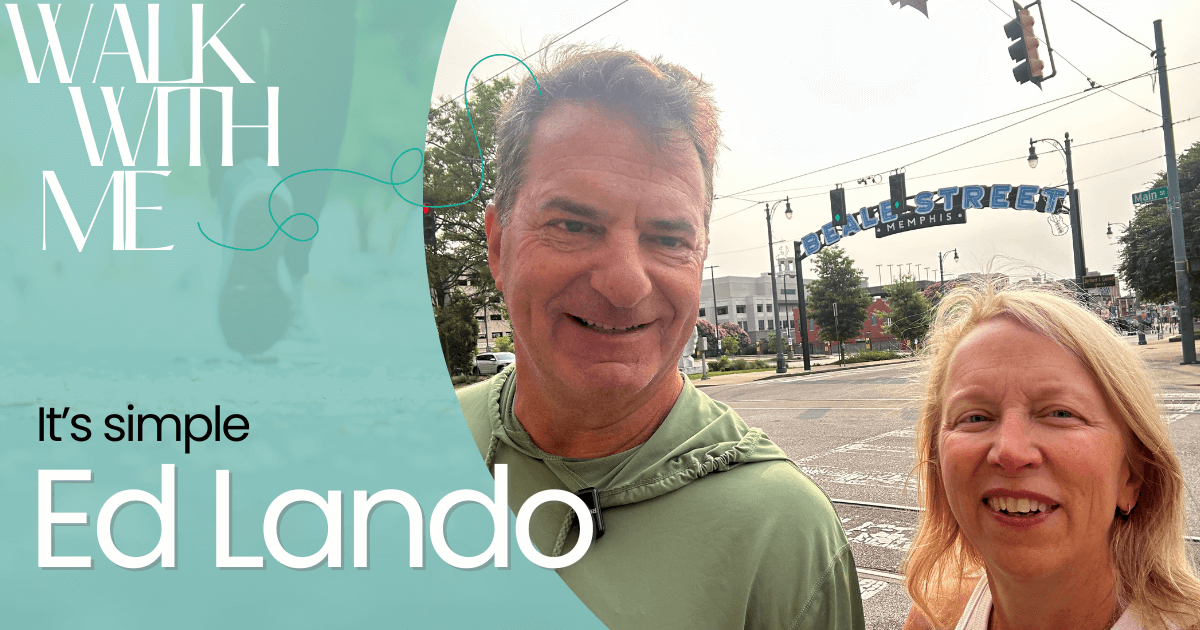As I round the final bend toward 50 walks, I am beginning to process all that I have learned. A strong inner voice urges me to keep it simple. We make things much too complicated. Starting to reflect on the insights I’ve learned, I am seeing that I knew most of them all along, but I had to get a little lost to truly see their wisdom. That’s the thing about learning – it’s not a checklist. No one and done. We learn some lessons over and over. And the best you can do is keep learning, keep growing and keep asking good questions. Embrace it all – the good, the bad and the ugly.
If you’re lucky enough, you have someone in your corner to simplify it when you can’t. I’ve developed quite a network. Where I find myself in the last three years… navigating a start up, understanding SaaS, unpacking leadership and now interviewing for the next chapter… I have turned to someone I have known almost my entire life for advice, Ed Lando. Our fathers were friends, so my dad trusted Ed. When I would ask to go somewhere, my dad would reply, “Is Ed going?” Whether it was true or not, I’d say yes, just so I could secure permission to go. I also knew if Ed were going to be there, it would be a good time. Ed lives every moment to the fullest. Better yet, he is present with you in every moment he is in.

Ed: We have so much going on in our lives between kids and siblings and family and friends and all these things. You get pulled in so many different directions, which means you have a busy life, which is great. But to lose one’s way, I mean, it’s common. It happens. It doesn’t happen all the time to everybody. But if someone says, I’ve never lost my way ever, whatever that means, it’s like, “Come on. Come on. So you broke the DNA strand?” I mean, it’s life… that happens. It’s natural. And so I think the key is when you realize it, fix it. If you want to fix it, fix it. I mean, again, keep it simple. Things aren’t complex. Life can get complex if you allow it. But what’s the simple solution? If it’s a relationship, work on the relationship. If it’s unworkable, then fix that.
Liz: I really appreciate that you added, “If it’s unworkable, fix that.” Not meaning to stay married or stay in the job, but okay, the time came…now we’ve got to pivot. I appreciate that because my inner voice, which sounds a lot like my dad, is to stay with it, fix it. His generation stayed with the same job forever. And jumping jobs was only because you were elevating up on the corporate ladder or the medical ladder or whatever. Never because there was just something else you wanted to do. That is not the way our world is anymore. But I can still hear him disappointed that I gave up on something because that’s the way he would have seen it.
Ed: So I’m not sure that’s the way it was. Again, you can only steer someone’s perceptions and thoughts so much. But I know you forever, you’re not a quitter.
Ed is right. It’s all about perception. What one person calls quitting, another calls pivoting. But ultimately, it comes down to knowing yourself—listening to your instincts and recognizing when both your head and heart are saying it’s time to move on, then having the courage to act on it. During those pivotal transitions, Ed becomes an invaluable ally. He’s built his career around seizing opportunities and connecting people with exactly the right resources to help them capitalize on their next chapter.
Ed: Really for me, I’ve always felt that one of the biggest benefits of being a headhunter or a recruiter leader is how much I’ve learned over the years about how business is run, how people manage teams, the difference between what are great leaders and average leaders. I ask them about what makes them great leaders or what they learn from other great leaders. And I’ve always said, my style, good, bad, or different, it’s been built based on all the smart people and all the talented people I’ve talked to and interviewed through my life. So it’s been a real advantage.
Liz: I love that. I love that you see all these people you’ve interviewed as people who gave something to you. So you brought it up. What is the difference between a good leader and a great leader? Or an average leader?
Ed: Yeah, I always tend to try to keep things really simple. So I’ve come to realize that in my opinion, it really comes down to two things: sincerity and trust.
The trust factor is that the team trusts that you have the knowledge to lead them. You know your craft, you’ve got the experience, you’ve had the education, whatever it is. But the sincerity part is they can believe what you say.
As for sincerity…
Ed: So one of the things that I learned to build into my feedback was, if someone wasn’t performing, one of my first questions really became, Is everything okay at home? I don’t want to get into your personal life, but is everything okay at home? And they say everything’s been great, then it’s like, Okay, well, you failed at this. I mean, if something was not going well at home, I understand how that would come into your professional life. But if everything’s okay at home, then the expectations are A, B, and C, and you’re missing B. So how can I help you get back on track because the company needs you to hit B, or whatever that is. But that, again, people want to know you care about them. I mean, you can’t fake it.
Ed includes sincerity. I have been using the word, authenticity, but I think we are using them interchangeably. I think my walks have collectively painted a picture of authentic leadership as deeply human, courageously vulnerable, and fundamentally about creating a culture where both leaders and those they serve can show up as their genuine selves while working toward shared goals and purposes. Authentic leadership isn’t a solo journey. The team around you matters in that culture. I always referred to it as getting the right people on the bus.

Ed: I worked for a CEO that used to say this all the time, “Software is software. It’s really all about the people and having the right people who want to be a part of the team who want to do great things.” Culture trumps strategy all day long. And I’ve been fortunate enough to be a part of companies that had great culture. And I’ve watched as leaders turned on that company, how fast the culture went downhill. For me, if I’m interviewing, that’s what I’m looking for… Can I trust the person? Do they know what I’m hiring them to do? Are they skilled for that? And do I want to be around them? Are they good people?
Liz: Well, I think a third one is that you’re in a constant state of learning. I mean, to me, that’s a good leader as well.
Ed: Well, so first of all, that’s a huge thing for me. Every team I’ve either been on or helped build or whatever, should always be in a constant state of learning. So that’s just a life thing for me. What’s the old saying, “When you’re green, you’re growing, when you’re ripe, you’re not.” So it’s one of those things. If you’re done learning, what’s your life about that?
If there is a third pillar, I would say you can always tell the successful leader because the successful leader gets people to work harder than they’ve ever worked in their life and love every second of it. I don’t hire people who don’t want to be great, who aren’t passionate. To me, I’ve always been around high growth entities, And to have a high-growth entity, you’ve got to have everybody all rowing together and love rowing…or at least the result of rowing.
Liz: Spoken from somebody who sat in the back of the boat, when the boat is rowing together, there is a transcendence that lifts the boat, and it feels like you’re not working anymore.
Ed: Yeah. How many times we’ve heard people say, If you love what you do, you will never work a day in your life.
Don’t get me started on rowing… or actually just wait until I really talk about rowing and the impact it had on my life. I was the Princeton varsity coxswain for three years. I know rowing. When eight rowers and a coxswain come together, there’s this moment of transcendence that happens – but only when everyone stops trying to prove they’re the strongest and starts pulling with their genuine effort, flaws and all. You’re sitting backwards, unable to see where you’re headed, completely trusting the person calling the cadence and your teammates most of whom you can’t see. There’s nowhere to hide your authentic effort; every catch of the oar, every weak pull, every moment you’re not fully present ripples through the entire boat. But when you find that sweet spot – when the collective rhythm tops individual glory – something magical happens. The boat begins to sing through the water, moving with a power that’s exponentially greater than the sum of its parts. That’s authentic leadership in action: creating the conditions where people can show up genuinely, trust completely, and move together toward something they couldn’t possibly achieve alone.
Ed: Leaders have to lead, but it’s also the leader’s job to develop the team and the people on the team that want to be developed to a higher level.
So the leader doesn’t do everything. That’s not the job of the leader. You have to empower. You can never have too many high-quality people, because in the end, people do run to the speed of the leader. So if the leader is a high-performing, great communicator, that’s how fast that team is going to run. I don’t care if you have all first-round draft picks. If your leader does not run fast and hard like the company needs them to, they will inherently slow down the team. So they will run to the speed of the leader and the quality of the leader.
Liz: And you’ll lose some people because of that speed.
Ed: Absolutely. It’s always the best ones you lose first because they want to run faster and harder, and they’re not getting that fulfillment. So it’s always the ones who are the average performers who don’t quit because it’s easy. They’re average performers. Nobody’s on their case because they have an ineffective leader. And the ones who are high performers see it. They don’t want to be on a team like that.
Good teams have a good culture. Rarely can a team be successful on the water (or the field… or the court) if there is turmoil in the locker room.
Liz: One of the things that’s been driving me nuts, in this past year especially, is the defensiveness that people have. You say something honest, you ask an honest question, and they’re immediate response is to be defensive. How do you counter that?
Ed: I just ask, why are you being defensive? I wasn’t attacking you personally. I didn’t say you were a bad person. I’m just saying, you didn’t do this. Don’t get defensive. Let’s talk through it so this doesn’t happen again because you’re not happy about it. That’s why you’re defensive. It’s not helping the company. So let’s work together to solve it. So there’s a piece of sincerity that comes with directness. I’m pretty direct just because I want to solve the problem. I want to help that person solve the problem.
Liz: You also told me no matter the conflict you have with somebody, you can put that aside and go have a beer with them at the end of the day.
Ed: If the culture is built the right way. The way you know you have the right culture is when that conflict happens. In the end, leaders have to lead. So the best way to come to a decision or an agreement is with a whole group agreeing, but that doesn’t always happen. So you have two or three different points of view, and there can only be one answer. That’s where the leader has to step in and say, “I’ve heard all of you. You may not like the decision, but this is the decision. This is the path forward for the company.” If you have the right culture and you build that, when you’ve hired that way, you’ve reinforced it… everybody is locked and loaded. So you may not agree with the decision. That ship has sailed. Execute to the best of your ability to make sure that decision is the best decision, because in the end, the paths are important, but it’s really the execution along the way that matters.
Liz: Lock in, baby.
Let me recap our conversation so far. I’ll set aside the rowing analogy for now and save that for another walk—let’s return to the bus. Picture a leader who’s always learning, someone who decides to take on a real challenge. She steps onto that empty bus because she wants to make a difference in her corner of the world. She invites, cajoles, and inspires the right people to join her, then builds a positive culture in those rows of seats. She does this by consistently following through on her commitments, by being authentic in both her vulnerability and empathy, and by offering the right balance of trust and accountability. That strong culture can weather the inevitable conflicts—like when seatmates in the third row start butting heads. But here’s what we haven’t discussed yet: everybody needs to know where they’re going. Before anyone steps on that bus, there needs to be a clear destination —that bright, unmistakable headsign that tells everyone exactly where this journey is taking us.

Ed: One thing I’ll absolutely say is, I don’t care how skilled and how good one is. If they’re not a good communicator, it’s hard to be a leader, an effective leader, because it is, going back to what I said earlier, it is about the presentation.
Liz: Trust, genuine, learning, communicator.
Ed: Being able to articulate. I mean, if you have all the thoughts, but you’re an ineffective communicator, you’re brash, You don’t use the words correctly. Whatever that is, your inability to communicate your skills, thoughts, and what you’re trying to motivate people to do are irrelevant because they just don’t pick it up.
If they don’t hear you the same way you intend for the words to be meant, that’s where you get offline. And I forget who said it, but a little bit of variance in the beginning becomes a huge variance down the road because you’re going in different paths.
Liz: And the thing you have to communicate the best is the vision for where we’re all going, where that boat’s headed.
Simon Sinek argues that it’s not enough for a leader to know their Why—they must be able to paint that vision so vividly that others can see it, feel it, and want to be part of it. When they do, you can feel it in the room. Meetings have a different energy. Conflicts get resolved differently because everyone’s arguing from the same foundational beliefs about what matters. When a leader successfully creates a shared vision, the effects ripple through every aspect of the organization. Hiring becomes easier because you’re attracting people who are already aligned with your purpose. Customer relationships deepen because your team’s authentic belief in the mission shows up in every interaction. Innovation accelerates because people aren’t just following instructions—they’re solving problems in service of something they care about. Your culture Sinek would argue becomes a “Circle of Safety” – where people feel safe to trust each other, to take risks, and to admit when they don’t know something.
Arrogance destroys that circle.
Liz: What do you do about that, arrogance?
Ed: I tell people this all the time. I have no problem with egos. The difference between ego and arrogance… Ego is I’m good, and I know I’m good, and I am good. Arrogance is I’m smart, you’re stupid, just do what I tell you.
Liz: Well, isn’t part of ego, I’m good, I know I’m good, and I know I can be better?
Ed: Absolutely. But my point is, arrogance is the exact opposite. People tend to interchange the word. They’re actually two different words. People tend to use them incorrectly.
Liz: How do you interview for arrogance?
Ed: Let him talk. Ask an open-ended question. Hey, tell me about a team you built and who’s the best person? Why were they good? How did you help them become better? I mean, it’s an attitude. You can usually pick up arrogance in people pretty quick. Hiring is more of an art than a science.
Look, my mom once gave us a book of sayings, and one of the sayings is, “Never try to teach a pig to dance. All that happens is you get muddy and you frustrate the pig.” And I use that all the time because it’s true. You don’t take a thoroughbred and have them plow fields. That’s not what the thoroughbred does. So you have to make sure… and this is the essence of hiring … or when you’re being hired, and you’re taking a job to make sure you want to work in that culture, and the problems they have are what you’re passionate about solving.
Liz: You really are talking about how a good leader has to have a balance between head and heart.
Ed: People want to work for people who care.
Liz: Yeah. And it’s amazing how many people are in jobs where they feel like they’re not working for somebody who cares, and they stay.
Ed: The other thing that most people who understand sales will tell you, the biggest competitor in the world, I don’t care what you’re selling, is apathy. It’s to not make the change.
Liz: Devil I know versus the devil I don’t.
Ed: It’s too much work to change. It’s inertia.
Liz: It’s inertia.
Ed: So in other words, you’re so used to going this way. For you to go this way takes a lot of effort. It’s a change of path.
Liz: But you would think changing jobs would be a priority. I know so many people in so many industries who are miserable, and they’ve just decided to stick it out.
Ed: It’s a lot of work changing jobs. I mean, number one, you’ve got to get your resume together. You have to find time. You got to hide it from your current boss. And then you got to go into a new culture. You got to meet people and there’s a lot that goes into it, psychologically, to really make that change. One of the things I’ve always felt… is everything works out in the end. Just make a decision. It’s going to work out in the end, mainly because you’re going to make it work out in the end.
What’s that saying? “Everything will be okay in the end. If it’s not okay, it’s not the end.” My dad paraphrased it differently. He would say “This too shall pass.” Four simple words that carried both hope and persistence. Without knowing any of this, a friend gave me a hand-painted magnet with those exact words. It now lives on my refrigerator, a daily reminder that feels like my dad is still speaking to me —telling me that challenges aren’t roadblocks, they’re simply part of the journey.
But Ed Lando takes it a step further, adding something my dad’s patient wisdom didn’t quite capture: agency. The power to act. While “this too shall pass” asks us to endure, Ed reminds us we don’t have to be passive passengers. If something isn’t serving us, we can change it. We have the courage to shape our own path through it all.
I have had an image of Ed in my mind throughout the process of writing this. As he approaches me, he is smiling…always smiling. Yes, he is present as I said at the outset, but he won’t allow me to wallow in reflection. Ed urges me to take positive action with a succinct cadence to his words and simple responses. For example, I texted him recently, “This situation is toxic.” He texted back, “You’ll fix it.” The simplicity is powerful and brings agency to the forefront.
His advice reaches far beyond business or hiring or even leadership. Be genuine. Build trust. It’s that simple.





